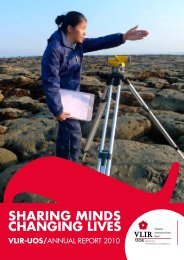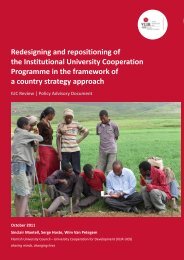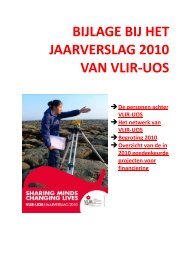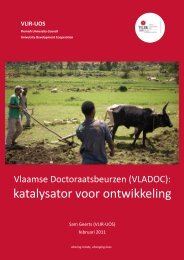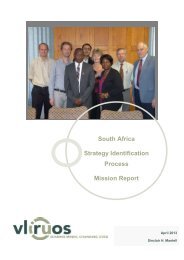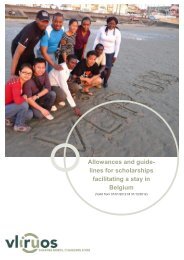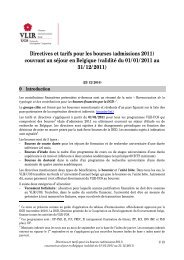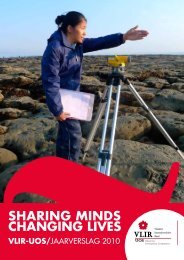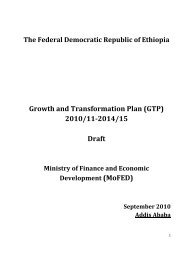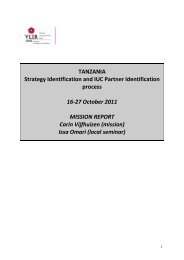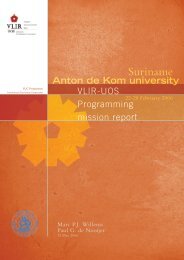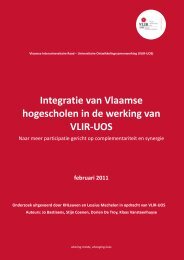Education Sector Development Program - VLIR-UOS
Education Sector Development Program - VLIR-UOS
Education Sector Development Program - VLIR-UOS
Create successful ePaper yourself
Turn your PDF publications into a flip-book with our unique Google optimized e-Paper software.
<strong>Education</strong> <strong>Sector</strong> <strong>Development</strong> <strong>Program</strong> IV<br />
in 2004/05 to 78.4% in 2008/2009 for grade 5, and<br />
from 26.3% in 2004/05 to 40.5% for grade 8.<br />
Despite this major achievement, the gender gap<br />
in education prevails at all levels of the system.<br />
The gap becomes more visible as one goes<br />
higher up the educational ladder. The share of<br />
girls admitted to preparatory education is only<br />
about a third. The number of female students in<br />
TVET is close to male students, but a closer look<br />
reveals that female students are concentrated in<br />
areas that are considered female’s. Among those<br />
enrolled in government institutions for a 2 or<br />
3 year diploma program 16.2%, for the four-year<br />
degree program 22.5%, for the Masters Degree<br />
program 9.2%, and for Ph.D. programs 6.4%<br />
were women. In Non-Formal <strong>Education</strong> (NFE)<br />
women’s enrolment and success rate is also<br />
lower than men’s, for reasons similar to those<br />
for formal education.<br />
The number of female teaching staff has also<br />
evolved considerably, but females still remain<br />
under-represented in all but ECCE. The share<br />
of women among primary school teachers<br />
increased slowly from 35.6% in 2004/05 to 37.2% in<br />
2008/2009 and from 8.5% to 11.7% over the same<br />
period in grades 9 to 12. The number of females in<br />
administrative and leadership positions remains<br />
extremely low. The number is decreasing as one<br />
moves from primary to secondary schools and<br />
institutes of higher learning. This deprives female<br />
students of the opportunity of looking up to role<br />
models. Also male teachers are more educated<br />
and qualified than female teachers.<br />
Main challenges<br />
• While the attitude of communities<br />
towards girls’ education is<br />
improving, it is still not supportive<br />
• Gender gap is still considerable at<br />
all levels of education, especially<br />
in preparatory secondary, TVET<br />
and in higher education<br />
• The proportion of females among<br />
the total teaching staff remains<br />
limited, despite the policy to<br />
attract 50% of females into<br />
teacher training.<br />
• Females are grossly<br />
underrepresented in positions<br />
of educational leadership and<br />
management as well as in<br />
teaching profession especially<br />
in secondary, TEVT and higher<br />
learning Institutions.<br />
• The curriculum needs to be<br />
made more consistently gendersensitive.<br />
• Gender mainstreaming during<br />
planning, implementing,<br />
monitoring and evaluation still<br />
remains low<br />
• Completion rate of girls at grade<br />
8 is significantly lower than boys<br />
• Participation of females in<br />
traditionally men dominated<br />
fields in TVET is low<br />
• Community attitude towards<br />
girls’ education is low and there<br />
is still gender based violence in<br />
and around schools and higher<br />
learning institutions.<br />
• Lack of separate toilet/latrine<br />
facilities for boys and girls.<br />
2. Expected program outcomes<br />
❚<br />
❚<br />
❚<br />
❚<br />
❚<br />
❚<br />
❚<br />
Capacity of structures to promote<br />
girls’ education enhanced<br />
Enrolment, retention and performance<br />
of deprived female students, including<br />
girls from pastoralist and agropastoralist<br />
groups, increased<br />
Access of girls to science and TVET<br />
increased, with emphasis on areas<br />
that are traditionally considered men’s<br />
Literacy level of women increased<br />
through greater participation in<br />
functional adult literacy<br />
Number of female teachers increased<br />
at all levels<br />
Number of female administrators,<br />
supervisors and directors at all levels<br />
increased<br />
A gender sensitive curriculum<br />
established and materials produced<br />
Key outcome targets<br />
Capacity of relevant structures will grow as<br />
demonstrated through a significant increase in<br />
the number of activities carried out.<br />
GPI for NER grades 1-4 will increase from 0.94<br />
(2008/2009) to 1.00 (2014/15)<br />
GPI for GER grades 1-8 will increase from 0.92<br />
(2008/2009) to 1.00 (2014/15)<br />
The dropout rate of deprived female students<br />
will decrease in line with the overall decrease in<br />
drop-outs<br />
72



